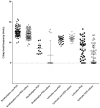Culture of primary ciliary dyskinesia epithelial cells at air-liquid interface can alter ciliary phenotype but remains a robust and informative diagnostic aid
- PMID: 24586956
- PMCID: PMC3934921
- DOI: 10.1371/journal.pone.0089675
Culture of primary ciliary dyskinesia epithelial cells at air-liquid interface can alter ciliary phenotype but remains a robust and informative diagnostic aid
Abstract
Background: The diagnosis of primary ciliary dyskinesia (PCD) requires the analysis of ciliary function and ultrastructure. Diagnosis can be complicated by secondary effects on cilia such as damage during sampling, local inflammation or recent infection. To differentiate primary from secondary abnormalities, re-analysis of cilia following culture and re-differentiation of epithelial cells at an air-liquid interface (ALI) aids the diagnosis of PCD. However changes in ciliary beat pattern of cilia following epithelial cell culture has previously been described, which has brought the robustness of this method into question. This is the first systematic study to evaluate ALI culture as an aid to diagnosis of PCD in the light of these concerns.
Methods: We retrospectively studied changes associated with ALI-culture in 158 subjects referred for diagnostic testing at two PCD centres. Ciliated nasal epithelium (PCD n = 54; non-PCD n 111) was analysed by high-speed digital video microscopy and transmission electron microscopy before and after culture.
Results: Ciliary function was abnormal before and after culture in all subjects with PCD; 21 PCD subjects had a combination of static and uncoordinated twitching cilia, which became completely static following culture, a further 9 demonstrated a decreased ciliary beat frequency after culture. In subjects without PCD, secondary ciliary dyskinesia was reduced.
Conclusions: The change to ciliary phenotype in PCD samples following cell culture does not affect the diagnosis, and in certain cases can assist the ability to identify PCD cilia.
Conflict of interest statement
Figures


References
-
- Kuehni CE, Frischer T, Strippoli MP, Maurer E, Bush A, et al. (2010) Factors influencing age at diagnosis of primary ciliary dyskinesia in European children. Eur Respir J 36: 1248–1258. - PubMed
-
- Lucas JS, Walker WT, Kuehni CE, Lazor R (2011) Primary Ciliary Dyskinesia. In: Courdier J-F, editors. Orphan Lung Diseases. European Respiratory Monograph. pp. 201–217.
-
- O'Callaghan C, Chetcuti P, Moya E (2010) High prevalence of primary ciliary dyskinesia in a British Asian population. Arch Dis Child 95: 51–52. - PubMed
-
- Barbato A, Frischer T, Kuehni CE, Snijders D, Azevedo I, et al. (2009) Primary ciliary dyskinesia: a consensus statement on diagnostic and treatment approaches in children. Eur Respir J 34: 1264–1276. - PubMed
Publication types
MeSH terms
Grants and funding
LinkOut - more resources
Full Text Sources
Other Literature Sources

